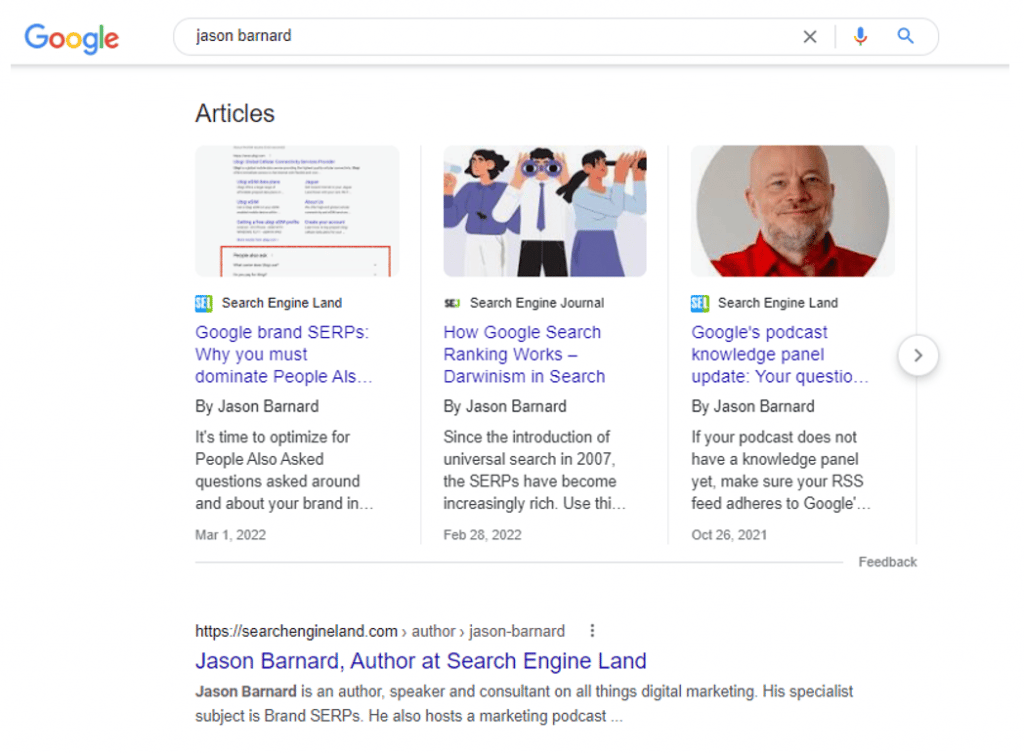Article Boxes (Article Carousels) in SEO: What You Need To Know

What are Article Boxes (Article Carousels) in SEO?
Simple Definition of Article Boxes (Article Carousels)
Article Boxes (Article Carousels) in Google SERPs (Search Engine Results Page) contain articles published by specific authors and related to the user’s search query. Article Boxes (Article Carousels) typically appear in a search for people who write articles on websites that Google recognises as authoritative sources within the industry, such as The Guardian, The New York Times, Search Engine Land, or Search Engine Journal.
At Kalicube®, this Rich Element (SERP feature) is called “Article Box” rather than a carousel, as they can sometimes appear in both carousel and box formats.
In this article, you will learn more about Article Boxes (Article Carousels), their importance for SEO and how they contribute to Brand SERP Optimisation.
What Do Article Boxes (Article Carousels) Look Like?
Users can see published articles in a series of three blocks in the SERP (as shown below). Each block contains the title of the article, the website Google recognises as the original source, the author, and the publication date. The box has the format of a carousel with navigation arrows to scroll horizontally through up to a dozen articles.
Here is an example of an Article Box for the search on the name “Jason Barnard”.

How Can I Trigger Article Boxes (Article Carousels) on my Brand SERP?
For an article to appear in the Article Boxes of Google SERPs, it must be published on a website that Google deems credible – that could be a company website, an authoritative personal blog, or a news website. But Google has its own algorithms for triggering Article Boxes for an entity.
The example above shows that Google will display articles from Search Engine Land and Search Engine Journal for an individual like Jason Barnard, the owner of Kalicube, because it assumes Jason authored those articles and those sites are considered credible in Jason’s industry. Articles from kalicube.com (the official website of the Kalicube company) are not displayed because kalicube.com is not recognized by Google as a news source.
How Can Article Boxes (Article Carousels) Fit Into Brand SERP Optimisation?
In Brand SERPs for people and companies, articles published on the official website are displayed in the Article Boxes if Google’s algorithms consider them to be highly authoritative and relevant to the brand’s target audience. If they are published on another website, Google needs to evaluate and understand the relationship between the person or company and the articles.
Article Boxes on your Brand SERP, whether you are a person or a company, give your audience a good impression that you are credible, authoritative and recognised in your industry. Importantly, once Google displays Article Boxes on a Brand SERP, the content is updated with the latest articles within a day of publication. This gives you direct control over what your audience sees when they google your brand name, which has a very positive impact on Brand SERP Optimisation.
Kalicube Solutions
- You can learn more about Brand SERPs and how you can control yours and ensure that you keep your potential clients focused on an accurate and convincing depiction of you with The Fundamentals of Brand SERPs for Business by Jason Barnard;
- You can browse our free resources (hundreds of articles, case studies and how-to’s to help you optimise your Brand SERP and manage your Knowledge Panel;
- You can opt-for the done-with-you Brand SERP and Knowledge Panel solutions where we do the hard work, identify the solutions and ensure that you achieve your goals and get Google “dancing to your tune.”





